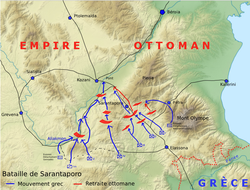Battle of Sarantaporo
| Battle of Sarandaporon | |||||||
|---|---|---|---|---|---|---|---|
| Part of the First Balkan War | |||||||
 Map of the battle |
|||||||
|
|||||||
| Belligerents | |||||||
|
|
|
||||||
| Commanders and leaders | |||||||
| Crown Prince Constantine | General Hasan Tahsin Pasha | ||||||
| Units involved | |||||||
| Army of Thessaly | VIII Provisional Corps | ||||||
| Strength | |||||||
| 5 divisions | 2 divisions | ||||||
| Casualties and losses | |||||||
| 182 dead, 995 wounded, plus the missing casualties of the 1st Infantry Regiment |
500 killed 1000 wounded 21 field artillery pieces |
||||||
The Battle of Sarantaporo, variously also transliterated as Sarantaporon or Sarandaporon (Greek: Μάχη του Σαρανταπόρου) took place on October 9-10 (O.S.), 1912. It was the first major battle fought between the Greek and Ottoman armies in the First Balkan War, and resulted in a Greek victory.
During the course of 1912, tensions grew in the Balkans between the Christian Balkan states, allied in the Balkan League, and the Ottoman Empire. From mid-September, both sides started mobilizing. Bulgaria and Serbia mobilized on September 16, Greece followed on September 17. On September 25, Montenegro declared war, followed on October 4 by Bulgaria and Serbia.
The Greek Army of Thessaly, under Crown Prince Constantine (with General Panagiotis Danglis as his chief of staff) consisted of six divisions (1st–6th), with the 7th Division forming at Larissa, a cavalry brigade and four independent Evzones battalions.
Against the Greek army, the Ottomans deployed their VIII Corps under General Hasan Tahsin Pasha, with three divisions: the regular (nizamiye) 22nd Division at Kozani and two reserve (redif) divisions. The Ottoman force totaled 14 infantry battalions, with further 11 in reserve, supported by 24 artillery pieces and three machine-gun companies. However, the Ottoman formations were up to 25% under strength, since the Ottomans had demobilized large parts of their army in August. The Ottomans hoped to hold the naturally strong position of the Sarantaporo passes, which had been extensively fortified under the supervision of a German military mission before the war.
The Greek army crossed the border on October 5. The 1st and 2nd Divisions engaged the 1,500 Ottoman covering forces, occupied Elassona and Deskati, and reached the Sarantaporo passes on October 7. Hopelessly outnumbered, the Ottoman forces withdrew to Sarantaporo.
...
Wikipedia
